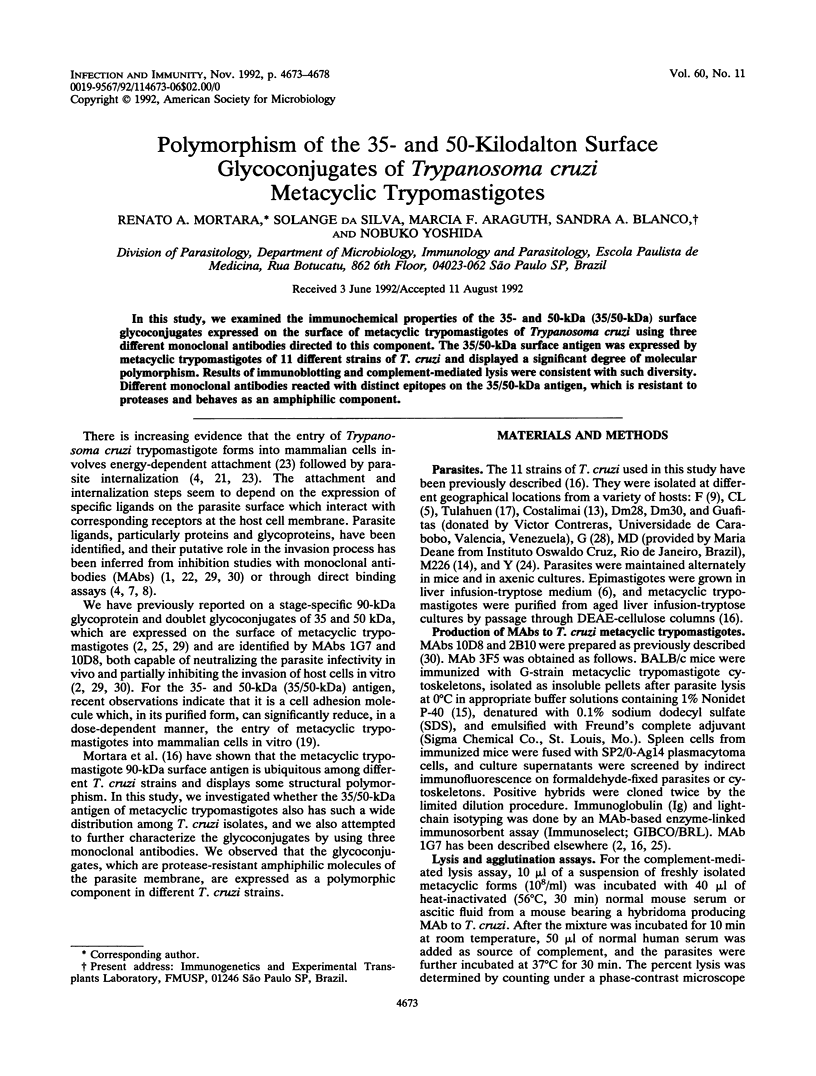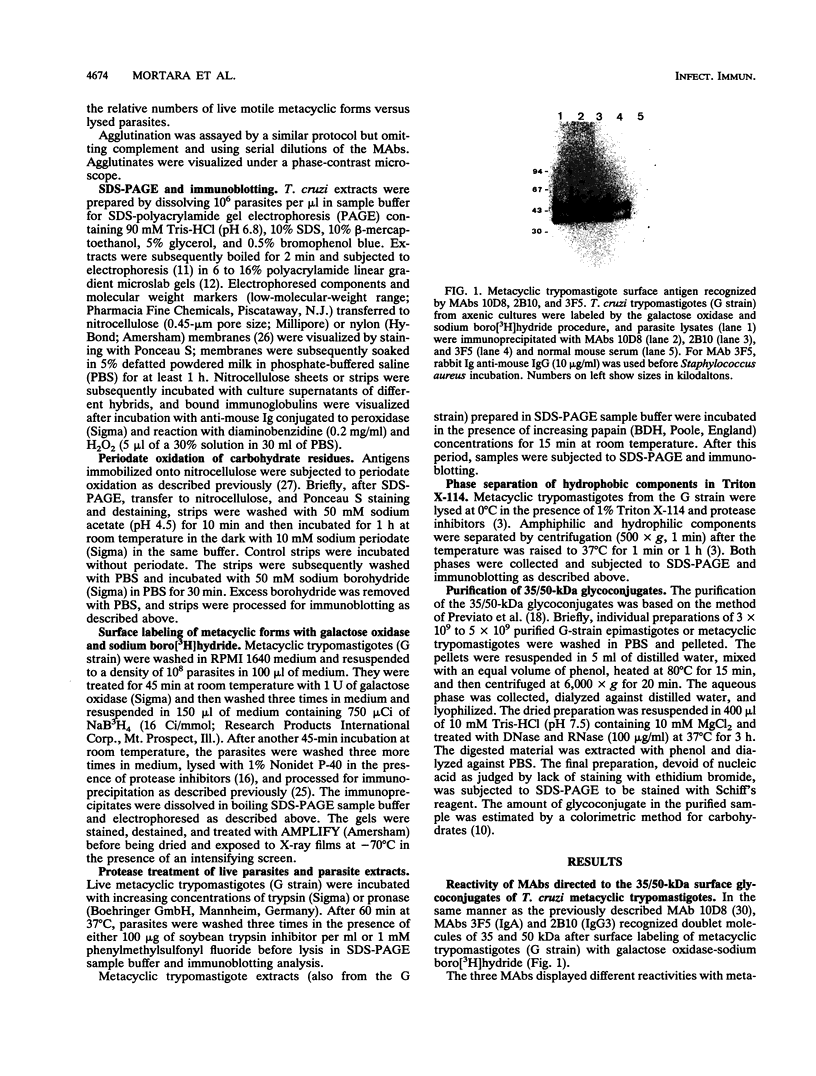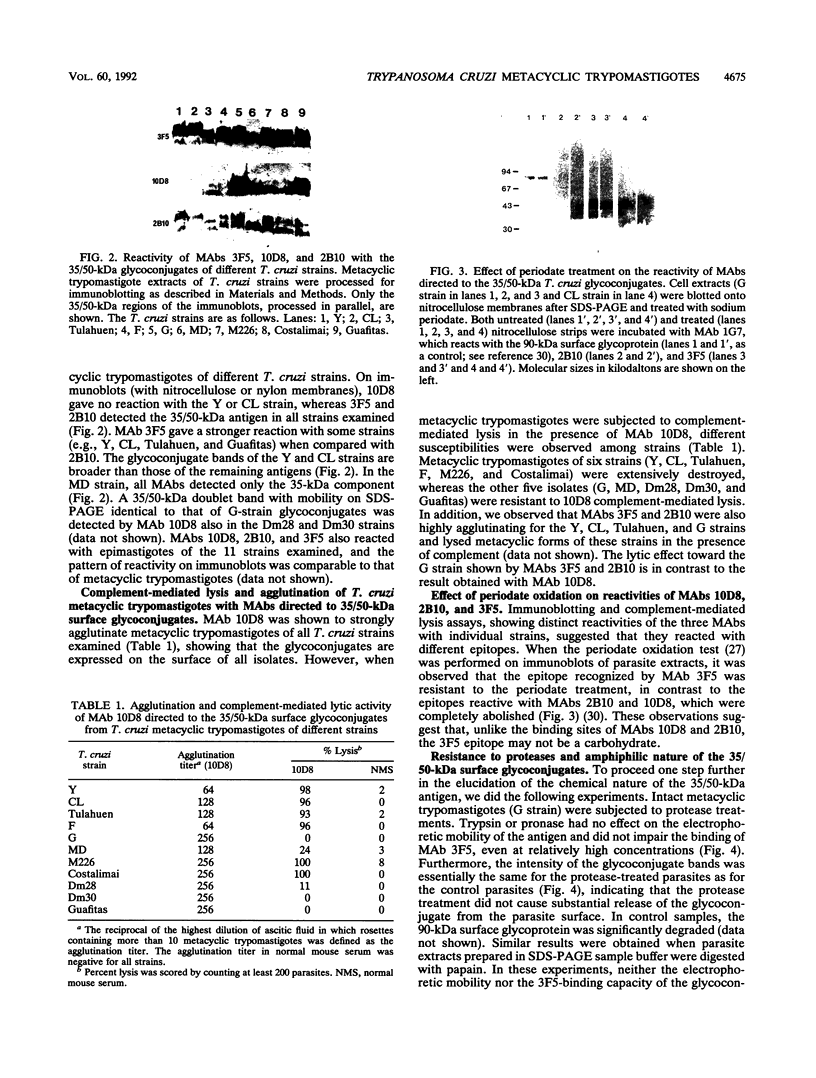Abstract
In this study, we examined the immunochemical properties of the 35- and 50-kDa (35/50-kDa) surface glycoconjugates expressed on the surface of metacyclic trypomastigotes of Trypanosoma cruzi using three different monoclonal antibodies directed to this component. The 35/50-kDa surface antigen was expressed by metacyclic trypomastigotes of 11 different strains of T. cruzi and displayed a significant degree of molecular polymorphism. Results of immunoblotting and complement-mediated lysis were consistent with such diversity. Different monoclonal antibodies reacted with distinct epitopes on the 35/50-kDa antigen, which is resistant to proteases and behaves as an amphiphilic component.
Full text
PDF





Images in this article
Selected References
These references are in PubMed. This may not be the complete list of references from this article.
- Alves M. J., Abuin G., Kuwajima V. Y., Colli W. Partial inhibition of trypomastigote entry into cultured mammalian cells by monoclonal antibodies against a surface glycoprotein of Trypanosoma cruzi. Mol Biochem Parasitol. 1986 Oct;21(1):75–82. doi: 10.1016/0166-6851(86)90081-2. [DOI] [PubMed] [Google Scholar]
- Araguth M. F., Rodrigues M. M., Yoshida N. Trypanosoma cruzi metacyclic trypomastigotes: neutralization by the stage-specific monoclonal antibody 1G7 and immunogenicity of 90 kD surface antigen. Parasite Immunol. 1988 Nov;10(6):707–712. doi: 10.1111/j.1365-3024.1988.tb00256.x. [DOI] [PubMed] [Google Scholar]
- BRENER Z., CHIARI E. VARIA C OES MORFOL'OGICAS OBSERVADAS EM DIFERENTES AMOSTRAS DE TRYPANOSOMA CRUZI. Rev Inst Med Trop Sao Paulo. 1963 Sep-Oct;5:220–224. [PubMed] [Google Scholar]
- Bordier C. Phase separation of integral membrane proteins in Triton X-114 solution. J Biol Chem. 1981 Feb 25;256(4):1604–1607. [PubMed] [Google Scholar]
- Boschetti M. A., Piras M. M., Henríquez D., Piras R. The interaction of a Trypanosoma cruzi surface protein with Vero cells and its relationship with parasite adhesion. Mol Biochem Parasitol. 1987 Jun;24(2):175–184. doi: 10.1016/0166-6851(87)90104-6. [DOI] [PubMed] [Google Scholar]
- CAMARGO E. P. GROWTH AND DIFFERENTIATION IN TRYPANOSOMA CRUZI. I. ORIGIN OF METACYCLIC TRYPANOSOMES IN LIQUID MEDIA. Rev Inst Med Trop Sao Paulo. 1964 May-Jun;6:93–100. [PubMed] [Google Scholar]
- Davis C. D., Kuhn R. E. Detection of antigens with affinity for host cell membrane polypeptides in culture supernatants of Trypanosoma cruzi. Infect Immun. 1990 Jun;58(6):1812–1816. doi: 10.1128/iai.58.6.1812-1816.1990. [DOI] [PMC free article] [PubMed] [Google Scholar]
- Davis C. D., Kuhn R. E. Selective binding of Trypanosoma cruzi to host cell membrane polypeptides. Infect Immun. 1990 Jan;58(1):1–6. doi: 10.1128/iai.58.1.1-6.1990. [DOI] [PMC free article] [PubMed] [Google Scholar]
- Deane M. P., Kloetzel J. Lack of protection against Trypanosoma cruzi by multiple doses of T. lewisi culture forms. A discussion on some strains of "lewisi". Exp Parasitol. 1974 Jun;35(3):406–410. doi: 10.1016/0014-4894(74)90046-0. [DOI] [PubMed] [Google Scholar]
- Laemmli U. K. Cleavage of structural proteins during the assembly of the head of bacteriophage T4. Nature. 1970 Aug 15;227(5259):680–685. doi: 10.1038/227680a0. [DOI] [PubMed] [Google Scholar]
- Matsudaira P. T., Burgess D. R. SDS microslab linear gradient polyacrylamide gel electrophoresis. Anal Biochem. 1978 Jul 1;87(2):386–396. doi: 10.1016/0003-2697(78)90688-7. [DOI] [PubMed] [Google Scholar]
- Mello D. A., Borges M. M., Chiarini L. H. Crescimento e diferenciaço "in vitro" de cepas de Trypanosoma cruzi, isolada de animais silvestres. Rev Saude Publica. 1980 Dec;14(4):569–581. doi: 10.1590/s0034-89101980000400012. [DOI] [PubMed] [Google Scholar]
- Mello D. A., Borges M. M. Primeiro encontro do Triatoma costalimai naturalmente infectado pelo Trypanosoma cruzi: estudo de aspectos biológicos da amostra isolada. Mem Inst Oswaldo Cruz. 1981 Jan-Mar;76(1):61–69. doi: 10.1590/s0074-02761981000100007. [DOI] [PubMed] [Google Scholar]
- Mortara R. A., Araguth M. F., Yoshida N. Reactivity of stage-specific monoclonal antibody 1G7 with metacyclic trypomastigotes of Trypanosoma cruzi strains: lytic property and 90,000 mol. wt surface antigen polymorphism. Parasite Immunol. 1988 Jul;10(4):369–378. doi: 10.1111/j.1365-3024.1988.tb00227.x. [DOI] [PubMed] [Google Scholar]
- Mortara R. A. Studies on trypanosomatid actin. I. Immunochemical and biochemical identification. J Protozool. 1989 Jan-Feb;36(1):8–13. doi: 10.1111/j.1550-7408.1989.tb02666.x. [DOI] [PubMed] [Google Scholar]
- PIZZI T., RUBIO M., PRAGER R., SILVA R. Acción de la cortisona en la infección experimental por Trypanosoma cruzi; communicación preliminar. Bol Inf Parasit Chil. 1952 Apr-Jun;7(2):22–24. [PubMed] [Google Scholar]
- Previato J. O., Andrade A. F., Pessolani M. C., Mendonça-Previato L. Incorporation of sialic acid into Trypanosoma cruzi macromolecules. A proposal for a new metabolic route. Mol Biochem Parasitol. 1985 Jun;16(1):85–96. doi: 10.1016/0166-6851(85)90051-9. [DOI] [PubMed] [Google Scholar]
- Sacks D. L., da Silva R. P. The generation of infective stage Leishmania major promastigotes is associated with the cell-surface expression and release of a developmentally regulated glycolipid. J Immunol. 1987 Nov 1;139(9):3099–3106. [PubMed] [Google Scholar]
- Schenkman S., Andrews N. W., Nussenzweig V., Robbins E. S. Trypanosoma cruzi invade a mammalian epithelial cell in a polarized manner. Cell. 1988 Oct 7;55(1):157–165. doi: 10.1016/0092-8674(88)90018-9. [DOI] [PubMed] [Google Scholar]
- Schenkman S., Diaz C., Nussenzweig V. Attachment of Trypanosoma cruzi trypomastigotes to receptors at restricted cell surface domains. Exp Parasitol. 1991 Jan;72(1):76–86. doi: 10.1016/0014-4894(91)90123-e. [DOI] [PubMed] [Google Scholar]
- Schenkman S., Robbins E. S., Nussenzweig V. Attachment of Trypanosoma cruzi to mammalian cells requires parasite energy, and invasion can be independent of the target cell cytoskeleton. Infect Immun. 1991 Feb;59(2):645–654. doi: 10.1128/iai.59.2.645-654.1991. [DOI] [PMC free article] [PubMed] [Google Scholar]
- Teixeira M. M., Yoshida N. Stage-specific surface antigens of metacyclic trypomastigotes of Trypanosoma cruzi identified by monoclonal antibodies. Mol Biochem Parasitol. 1986 Mar;18(3):271–282. doi: 10.1016/0166-6851(86)90085-x. [DOI] [PubMed] [Google Scholar]
- Towbin H., Staehelin T., Gordon J. Electrophoretic transfer of proteins from polyacrylamide gels to nitrocellulose sheets: procedure and some applications. Proc Natl Acad Sci U S A. 1979 Sep;76(9):4350–4354. doi: 10.1073/pnas.76.9.4350. [DOI] [PMC free article] [PubMed] [Google Scholar]
- Woodward M. P., Young W. W., Jr, Bloodgood R. A. Detection of monoclonal antibodies specific for carbohydrate epitopes using periodate oxidation. J Immunol Methods. 1985 Apr 8;78(1):143–153. doi: 10.1016/0022-1759(85)90337-0. [DOI] [PubMed] [Google Scholar]
- Yoshida N., Blanco S. A., Araguth M. F., Russo M., González J. The stage-specific 90-kilodalton surface antigen of metacyclic trypomastigotes of Trypanosoma cruzi. Mol Biochem Parasitol. 1990 Feb;39(1):39–46. doi: 10.1016/0166-6851(90)90006-8. [DOI] [PubMed] [Google Scholar]
- Yoshida N., Mortara R. A., Araguth M. F., Gonzalez J. C., Russo M. Metacyclic neutralizing effect of monoclonal antibody 10D8 directed to the 35- and 50-kilodalton surface glycoconjugates of Trypanosoma cruzi. Infect Immun. 1989 Jun;57(6):1663–1667. doi: 10.1128/iai.57.6.1663-1667.1989. [DOI] [PMC free article] [PubMed] [Google Scholar]
- Yoshida N. Surface antigens of metacyclic trypomastigotes of Trypanosoma cruzi. Infect Immun. 1983 May;40(2):836–839. doi: 10.1128/iai.40.2.836-839.1983. [DOI] [PMC free article] [PubMed] [Google Scholar]









